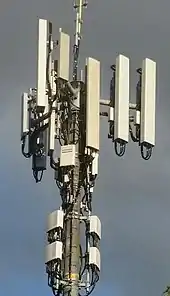Antenna efficiency
In antenna theory, antenna efficiency is most often used to mean radiation efficiency. In the context of antennas, one often just speaks of "efficiency." It is a measure of the electrical efficiency with which a radio antenna converts the radio-frequency power accepted at its terminals into radiated power. Likewise, in a receiving antenna it describes the proportion of the radio wave's power intercepted by the antenna which is actually delivered as an electrical signal. It is not to be confused with aperture efficiency which applies to aperture antennas such as the parabolic reflector.
| Part of a series on |
| Antennas |
|---|
 |
Definition
Radiation efficiency is defined by IEEE Std 145-1993[1] "Standard Definitions of Terms for Antennas" as "The ratio of the total power radiated by an antenna to the net power accepted by the antenna from the connected transmitter." It is sometimes expressed as a percentage (less than 100), and is frequency dependent. It can also be described in decibels.
For wire antennas which have a defined radiation resistance the radiation efficiency is the ratio of the radiation resistance to the total resistance of the antenna including ground loss (see below) and conductor resistance.[2][3] In practical cases the resistive loss in any tuning and/or matching network is often included, although network loss is strictly not a property of the antenna.
For other types of antenna the radiation efficiency is less easy to calculate and is usually determined by measurements.
The gain of an antenna is the directivity multiplied by the radiation efficiency, as described in Std 145-1993.
Ohmic and ground loss
The loss of radio-frequency power to heat can be subdivided many different ways, depending on the number of significantly lossy objects electrically coupled to the antenna, and on the level of detail desired. Typically the simplest is to consider two types of loss: ohmic loss and ground loss.[lower-alpha 1]
When discussed as distinct from ground loss, the term ohmic loss refers to the heat-producing resistance to the flow of radio current in the conductors of the antenna, their electrical connections, and possibly loss in the antenna's feed cable. Because of the skin effect, resistance to radio-frequency current is generally much higher than direct current resistance.
For vertical monopoles and other antennas placed near the ground, ground loss occurs due to the electrical resistance encountered by radio-frequency fields and currents passing through the soil in the vicinity of the antenna, as well as ohmic resistance in metal objects in the antenna's surroundings (such as its mast or stalk), and ohmic resistance in its ground plane / counterpoise, and in electrical and mechanical bonding connections. When considering antennas that are mounted a few wavelengths above the earth on a non-conducting, radio-transparent mast, ground losses are small enough compared to conductor losses that they can be ignored.[lower-alpha 2]
Aperture efficiency
This is a distinct concept applied to aperture antennas such as a parabolic antenna and is a measure of the reduction in power gain caused by non-uniform aperture illumination by the feed antenna. In a typical situation the reflector is illuminated with a reduced power-density at the edge compared with the centre, in order to reduce sidelobes and other effects. This causes a reduction in gain: the ratio of the gain of the tapered aperture distribution to the theoretical gain of a uniformly illuminated aperture is the aperture efficiency.[2]
Footnotes
- Technically, all heat-producing voltage loss is “Ohmic” electrical resistance, but in this context the term is used to refer only to loss in the radiating parts of the antenna and their feeds.
- Some of the waves radiated by any antenna will be reflected off of the ground and back up into the air. Because this typically happens far from the antenna, losses associated with distant ground reflection are usually considered separately from losses in the ground near the antenna.
References
- Standard Definitions of Terms for Antennas. IEEE. 1993. doi:10.1109/IEEESTD.1993.119664. ISBN 978-1-55937-317-3. Std 145-1993.
- Weelkes, W.J. (1968). Antenna Engineering. New York, NY: McGraw Hill Book Company. pp. 29, 256–258.
- Silver, H. Ward; Ford, Stephen R.; Wilson, Mark J., eds. (2011). ARRL Antenna Book (22 ed.). Newington, CT: American Radio Relay League. ISBN 978-0-87259-680-1.